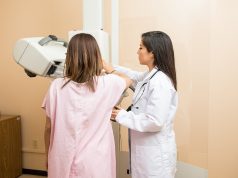Extending biennial mammography from age 75 to 80 years is cost-effective, but the absolute number of deaths averted is small
MONDAY, Nov. 22, 2021 (HealthDay News) — Annual mammography beyond 75 years is not cost-effective, but extending biennial screening mammography to 80 years is, according to a study published online Nov. 23 in the Annals of Internal Medicine.
John T. Schousboe, M.D., Ph.D., from the University of Minneapolis, and colleagues estimated the benefits, harms, and cost-effectiveness of extending mammography to age 80, 85, or 90 years using a Markov microsimulation model for a target population of U.S. women aged 65 to 90 years in groups defined by Charlson comorbidity score (CCS).
The researchers found that for comorbidity scores of 0, 1, and 2, extending biennial mammography from age 75 to 80 years averted 1.7, 1.4, and 1.0 breast cancer deaths and increased days of life gained by 5.8, 4.2, and 2.7 per 1,000 women, respectively. Beyond age 75 years, annual mammography was not cost-effective, but extending biennial mammography to age 80 years was ($54,000, $65,000, and $85,000 per quality-adjusted life-year [QALY] gained for women with CCS of 0, 1, and ≥2, respectively). The investigators observed double the number of overdiagnosis cases than the number of deaths averted from breast cancer. In sensitivity analyses, costs per QALY gained were sensitive to changes in incidence of invasive cancer and shift of breast cancer stage with mammography screening.
“It is unlikely that a cost-effectiveness study will lead to deimplementation of annual screening in American women aged 75 years or older,” writes the author of an accompanying editorial. “However, such studies might encourage development of models for risk-based screening.”
Editorial (subscription or payment may be required)
Copyright © 2021 HealthDay. All rights reserved.








